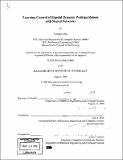Learning control of bipedal dynamic walking robots with neural networks
Author(s)
Hu, Jianjuen, 1964-
DownloadFull printable version (13.11Mb)
Advisor
Gill A. Pratt.
Terms of use
Metadata
Show full item recordAbstract
Stability and robustness are two important performance requirements for a dynamic walking robot. Learning and adaptation can improve stability and robustness. This thesis explores such an adaptation capability through the use of neural networks. Three neural network models (BP, CMAC and RBF networks) are studied. The RBF network is chosen as best, despite its weakness at covering high dimensional input spaces. To overcome this problem, a self-organizing scheme of data clustering is explored. This system is applied successfully in a biped walking robot system with a supervised learning mode. Generalized Virtual Model Control (GVMC) is also proposed in this thesis, which is inspired by a bio-mechanical model of locomotion, and is an extension of ordinary Virtual Model Control. Instead of adding virtual impedance components to the biped skeletal system in virtual Cartesian space, GVMC uses adaptation to approximately reconstruct the dynamics of the biped. The effectiveness of these approaches is proved both theoretically and experimentally (in simulation).
Description
Thesis (Elec.E.)--Massachusetts Institute of Technology, Dept. of Electrical Engineering and Computer Science, 1998. Includes bibliographical references (p. 90-94).
Date issued
1998Department
Massachusetts Institute of Technology. Department of Electrical Engineering and Computer SciencePublisher
Massachusetts Institute of Technology
Keywords
Electrical Engineering and Computer Science